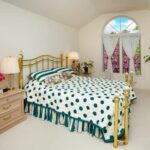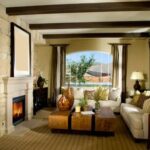Have you ever wondered how to decorate an English Tudor home? The distinctive charm and timeless appeal of these historic houses make them a popular choice for homeowners looking to infuse their living spaces with character and tradition. In this article, we will delve into the rich history of English Tudor architecture, explore the unique features that define these homes, and provide practical tips on how to decorate their interiors and exteriors in a way that honors their heritage.
English Tudor homes are known for their picturesque beauty, striking details, and cozy ambiance. From the exposed beams and leaded glass windows to the rich color palettes and traditional furniture, there is much to embrace when it comes to creating a truly authentic Tudor home.
Whether you are a proud owner of a Tudor-style house or simply drawn to its Old World allure, understanding the key elements of this architectural style can help you bring its unique charm into your own living space.
Through this article, we aim to guide you through the process of decorating an English Tudor home, from choosing the right color palette and furniture to incorporating rich textures and fabrics. We will also explore how lighting can enhance the warmth and ambience of a Tudor home, as well as ways to extend its style to outdoor spaces through garden landscaping.
Join us on a journey through history and design as we uncover the secrets to bringing your English Tudor home to life with timeless decor.
History of English Tudor Architecture
The English Tudor architectural style has a rich and fascinating history that dates back to the early 16th century. It was during the reign of the Tudor monarchs in England that this unique style emerged, characterized by its half-timbering, large chimneys, and steeply pitched roofs. This distinctive design reflects a blend of medieval and Renaissance influences, making it a truly timeless and captivating aesthetic.
One of the key features of English Tudor architecture is the use of exposed wooden beams, which were originally structural elements but became an integral part of the decorative appeal of Tudor homes. Additionally, leaded glass windows, often with diamond or rectangular panes, are another hallmark of this style. These elements give Tudor homes their unmistakable charm and character, harking back to a bygone era of craftsmanship and artistry.
As the style evolved over time, it also incorporated elements from other design movements such as Arts and Crafts and Gothic Revival. This fusion resulted in a distinct aesthetic that continues to captivate homeowners and enthusiasts alike. By understanding the roots of English Tudor architecture, one can gain a deeper appreciation for its enduring appeal and timeless elegance.
Embracing the Unique Features
When it comes to decorating an English Tudor home, one of the most important aspects to embrace is the unique architectural features that give these homes their charm. Exposed beams and leaded glass are two distinctive elements that are characteristic of Tudor architecture, and highlighting them can truly bring out the beauty of these homes.
Exposed Beams
The exposed beams in Tudor homes are not only structural elements but also add a lot of character to the interior. To highlight these features, consider emphasizing the natural wood by using a clear finish or lightly staining them.
This will allow the beauty of the wood to shine through and create a warm and inviting atmosphere. Additionally, choosing paint colors for the walls that complement the wood tones can help draw attention to the exposed beams and create a cohesive look.
Leaded Glass
Leaded glass windows are another iconic feature of English Tudor homes. These windows often feature intricate patterns and add a touch of old-world charm to the interiors. To make the most of leaded glass windows, consider using window treatments that allow plenty of natural light to filter through while still providing some privacy. This will showcase the beauty of the leaded glass while maintaining functionality.
Embracing and highlighting these unique features is essential when decorating an English Tudor home. By paying attention to details such as exposed beams and leaded glass, homeowners can truly bring out the timeless beauty of this architectural style in their living spaces.
Color Palette
Choosing the right color palette is crucial when decorating an English Tudor home interior. The characteristic features of this architectural style, such as exposed beams and leaded glass, create a cozy and traditional atmosphere that can be complemented by the perfect hues. When selecting colors for a Tudor home, it’s essential to consider the warmth and richness that will enhance the unique features of the space.
One classic approach to color in a Tudor home is to stick with earth tones. Rich browns, deep greens, warm grays, and muted yellows are all excellent choices for creating a cozy and inviting ambiance. These colors not only complement the exposed wooden beams and leaded glass windows but also evoke a sense of history and tradition that is characteristic of Tudor homes.
For those who prefer a more vibrant approach, jewel tones can also work well in a Tudor home interior. Deep blues, emerald greens, and ruby reds can add a touch of elegance and opulence to the space while still maintaining the cozy and traditional feel. When using these bold colors, it’s important to balance them with neutral shades to prevent the space from feeling overwhelming.
In addition to wall colors, accent pieces such as upholstery, curtains, and rugs should also be chosen with care to ensure they harmonize with the overall color palette of the room. By selecting colors that complement the unique features of an English Tudor home, homeowners can create an interior that feels both timeless and comfortable.
| Color Selection | Description |
|---|---|
| Earth Tones | Rich browns, deep greens, warm greys, muted yellows |
| Jewel Tones | Deep blues, emerald greens, ruby reds |
Furniture and Decor
When it comes to decorating an English Tudor home, choosing the right furniture and decor is essential to complement the traditional aesthetic of this architectural style. From the living room to the bedroom, each space in a Tudor home can be adorned with pieces that enhance the charm and character of the interior.
Traditional Furniture Styles
To create a cohesive look in a Tudor home, opt for furniture pieces that are in line with the traditional aesthetic. Look for items such as Chesterfield sofas, wingback chairs, and carved wooden tables. These pieces not only add elegance to the interior but also reflect the time period from which the Tudor style originated.
Antique Finds
Incorporating antique furniture into a Tudor home can further accentuate its historical appeal. Look for vintage items like wooden chests, tapestries, and canopy beds to bring a sense of timelessness to the decor. These unique finds add character and individuality to each room while staying true to the traditional style of an English Tudor home.
Accessories and Accents
When it comes to selecting decor for a Tudor home, focus on adding accents that complement the traditional aesthetic. Think brass candlesticks, ornate mirrors, and stained glass windows. These accessories not only add visual interest but also contribute to creating a warm and inviting atmosphere in each living space. By paying attention to these details, you can bring out the timeless beauty of an English Tudor home through carefully selected furniture and decor pieces.
Fabrics and Textures
When it comes to decorating an English Tudor home, the use of rich textiles and cozy materials plays a crucial role in enhancing the traditional aesthetic of this architectural style. Incorporating fabrics and textures that evoke warmth and comfort is essential to bringing out the charm of a Tudor home interior.
To achieve the desired look, consider incorporating the following elements into your decor:
- Tapestry: Utilize tapestries featuring intricate patterns and designs that add a touch of old-world elegance to your space. Hang them on the walls or drape them over furniture for a classic Tudor feel.
- Velvet: Introduce velvet upholstery or throw pillows to create a sense of luxury and sophistication in your Tudor home. The deep, plush texture of velvet adds depth and richness to the overall decor.
- Wool and tweed: Embrace the cozy vibes of a Tudor home by integrating wool and tweed fabrics into the decor. From upholstered furniture to throw blankets, these materials exude warmth and comfort.
- Embroidery: Infuse your space with intricate embroidery on cushions, curtains, or table linens. This adds a touch of craftsmanship and character to your Tudor home decor.
Incorporating these rich textiles and cozy materials will help you achieve an inviting and timeless ambiance in your English Tudor home. By paying attention to detail and selecting pieces that reflect the traditional aesthetic of this architectural style, you can create a space that feels both elegant and comfortable at the same time.
Lighting
When it comes to decorating an English Tudor home, lighting plays a crucial role in enhancing the warmth and ambiance of the space. The unique architectural features of a Tudor home, such as the exposed beams and leaded glass windows, create a cozy and inviting atmosphere that can be further accentuated with the right lighting choices.
Whether you are decorating the interior or exterior of your Tudor home, there are several key considerations to keep in mind when it comes to lighting.
One of the most important factors to consider when choosing lighting for a Tudor home is to complement the traditional aesthetic of the space. Look for light fixtures that have a timeless and classic design, such as wrought iron chandeliers or sconces with intricate metalwork. These types of fixtures not only provide ample illumination but also contribute to the overall charm and character of a Tudor home.
In addition to selecting appropriate light fixtures, it’s also essential to consider the type of light bulbs being used. Warm-toned bulbs can enhance the cozy atmosphere of a Tudor home, while dimmer switches can help control the level of lighting in different areas of the house. By carefully choosing and positioning lighting elements throughout your English Tudor home, you can truly enhance its warmth and ambiance, creating a welcoming environment for both residents and visitors alike.
Garden and Exterior
When it comes to decorating an English Tudor home, it’s important to extend the style and charm of the interior to the outdoor spaces. One way to do this is by incorporating Tudor-inspired landscaping that complements the architectural features of the home. Here are some key elements to consider when designing the garden and exterior of an English Tudor home:
1. Hardscaping: Start by incorporating hardscaping elements that add a sense of history and tradition to the outdoor space. Consider using materials such as brick, stone, or slate for pathways, patios, and retaining walls. These materials were commonly used in traditional English Tudor architecture and will help tie the outdoor space to the style of the home.
2. Formal Gardens: English Tudor homes often feature formal gardens with neatly manicured hedges, boxwood parterres, and symmetrical plantings. Consider adding these elements to your outdoor space to create a cohesive look that reflects the traditional aesthetic of a Tudor home.
3. Cottage Garden Plantings: In addition to formal gardens, English Tudor homes also often feature cottage garden plantings with profusions of flowers, herbs, and perennial borders. Consider planting classic Tudor flowers such as roses, peonies, lavender, and hollyhocks to add color and fragrance to your outdoor space.
By incorporating these elements into your garden and exterior spaces, you can effectively extend the style of your English Tudor home outdoors. This cohesive approach will create a timeless and enchanting atmosphere that celebrates the rich history and charm of Tudor architecture.
Conclusion
In conclusion, decorating an English Tudor home is about embracing the rich history and unique features of this architectural style. From the exposed beams to the leaded glass windows, every element of a Tudor home tells a story of tradition and elegance. By choosing the right color palette, furniture, fabrics, lighting, and exterior landscaping, homeowners can bring their Tudor home to life with timeless decor that honors its classic charm.
It’s important to remember that when decorating a Tudor home, less is often more. The beauty of the architecture speaks for itself, so it’s essential to choose decor and furnishings that complement rather than compete with the traditional aesthetic. Rich textiles and cozy materials can add warmth and character to the interior spaces, while carefully selected lighting fixtures can enhance the ambiance of a Tudor home.
When extending the style to outdoor spaces, homeowners should consider incorporating Tudor-inspired landscaping to create a seamless transition from indoors to outdoors. By paying attention to every detail, from the interior decor to the exterior garden, homeowners can truly bring their English Tudor home to life in a way that feels timeless and elegant.
Ultimately, creating a welcoming and charming atmosphere that reflects the history and character of this iconic architectural style is key when decorating an English Tudor home.
Frequently Asked Questions
How Did Tudors Decorate Their Homes?
Tudors decorated their homes with rich and opulent furnishings, including elaborate tapestries, ornate woodwork, and grand stone fireplaces. They used intricate patterns in their textiles and often adorned their walls with portraits or large-scale religious art. Additionally, Tudor homes featured furniture made of dark woods like oak or walnut, giving them a sense of elegance and luxury.
How to Decorate an English Tudor House?
To decorate an English Tudor house, it’s important to embrace its historical characteristics while also incorporating modern elements. One can start by highlighting the exposed timber beams, which are a signature feature of these homes.
Dark wooden furniture and rich textiles can complement the traditional aspects, while contemporary light fixtures and minimalist decor items can provide a balance between old and new.
What Colors for a Tudor Home?
When choosing colors for a Tudor home, one should consider traditional earth tones such as deep reds, greens, browns, and golds to complement the rich woodwork found in these houses. However, it’s also essential to incorporate lighter hues like cream or ivory to prevent the space from feeling too heavy or dark.
These colors can be used on walls, upholstery, and accents to create a harmonious atmosphere within the home.

I’m thrilled to be your companion on this exciting journey through the world of home decor and design. With a passion for turning houses into homes and a keen eye for the finer details, I’m here to help you transform your living spaces into beautiful, functional, and meaningful havens.





